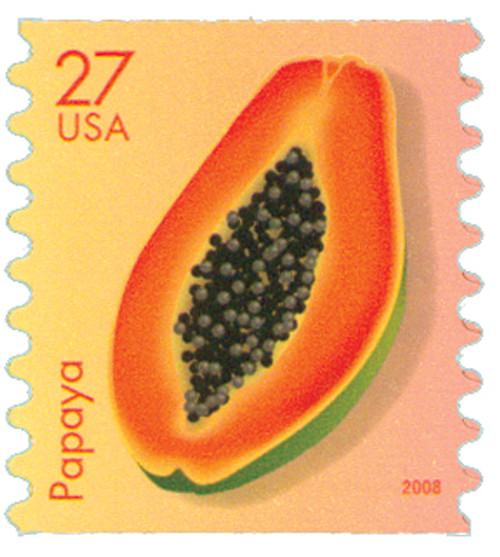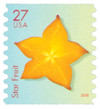
# 4261 - 2008 27c Tropical Fruit: Star Fruit, coil
Tropical Fruit
Star Fruit
Die Cut 8.5
Issue Date: April 25, 2008
City: Burlingame, CA
In 2008, the United States Postal Service issued a set of five stamps featuring tropical fruits. Tropical fruits grow in the areas centered around the equator. The climate in the tropics varies from warm and humid to hot and dry. This is crucial to the survival of tropical fruits. Most tropical fruits require lots of sun, and cannot survive freezing temperatures.
The carambola (or star fruit) is native to Sri Lanka and the Moluccas. The small, egg-shaped fruit has five “ribs” that, when cut open, create star-shaped slices. The carambola has thin, yellow skin and crisp, juicy, yellow flesh.
Native to China, the kiwifruit is also its national fruit. The “hairy,” greenish-brown skin encloses green or gold flesh filled with rows of small, black, edible seeds. The pomegranate, native to Afghanistan, Pakistan, Iran, and northern India, is a small, hexagonal-shaped fruit. Its thick, red skin holds about 600 edible seeds, surrounded by white to red pulp.
Guava, believed to originate in Mexico and Central America, is a round, oval, or pear-shaped fruit. Its yellow and pink-blushed skin is filled with grainy white, yellow, or pink flesh and 100 to 500 seeds.
The papaya, also native to Mexico and Central America, is a yellow, orange, or pink fruit that can weigh from one to ten pounds. Papayas are also filled with edible, spicy, black seeds.
Tropical Fruit
Star Fruit
Die Cut 8.5
Issue Date: April 25, 2008
City: Burlingame, CA
In 2008, the United States Postal Service issued a set of five stamps featuring tropical fruits. Tropical fruits grow in the areas centered around the equator. The climate in the tropics varies from warm and humid to hot and dry. This is crucial to the survival of tropical fruits. Most tropical fruits require lots of sun, and cannot survive freezing temperatures.
The carambola (or star fruit) is native to Sri Lanka and the Moluccas. The small, egg-shaped fruit has five “ribs” that, when cut open, create star-shaped slices. The carambola has thin, yellow skin and crisp, juicy, yellow flesh.
Native to China, the kiwifruit is also its national fruit. The “hairy,” greenish-brown skin encloses green or gold flesh filled with rows of small, black, edible seeds. The pomegranate, native to Afghanistan, Pakistan, Iran, and northern India, is a small, hexagonal-shaped fruit. Its thick, red skin holds about 600 edible seeds, surrounded by white to red pulp.
Guava, believed to originate in Mexico and Central America, is a round, oval, or pear-shaped fruit. Its yellow and pink-blushed skin is filled with grainy white, yellow, or pink flesh and 100 to 500 seeds.
The papaya, also native to Mexico and Central America, is a yellow, orange, or pink fruit that can weigh from one to ten pounds. Papayas are also filled with edible, spicy, black seeds.










